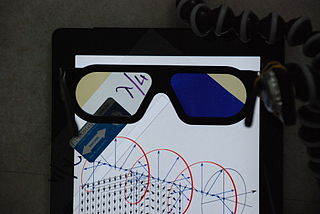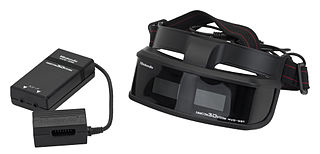Related Research Articles

A graphics card is a computer expansion card that generates a feed of graphics output to a display device such as a monitor. Graphics cards are sometimes called discrete or dedicated graphics cards to emphasize their distinction to integrated graphics processor on the motherboard or the CPU. A graphics processing unit (GPU) that performs the necessary computations is the main component in a graphics card, but the acronym "GPU" is sometimes also used to erroneously refer to the graphics card as a whole.

Stereoscopy is a technique for creating or enhancing the illusion of depth in an image by means of stereopsis for binocular vision. The word stereoscopy derives from Greek στερεός (stereos) 'firm, solid', and σκοπέω (skopeō) 'to look, to see'. Any stereoscopic image is called a stereogram. Originally, stereogram referred to a pair of stereo images which could be viewed using a stereoscope.

3dfx Interactive, Inc. was an American computer hardware company headquartered in San Jose, California, founded in 1994, that specialized in the manufacturing of 3D graphics processing units, and later, video cards. It was a pioneer in the field from the late 1990s until 2000.
The refresh rate, also known as vertical refresh rate or vertical scan rate in reference to terminology originating with the cathode-ray tubes (CRTs), is the number of times per second that a raster-based display device displays a new image. This is independent from frame rate, which describes how many images are stored or generated every second by the device driving the display. On CRT displays, higher refresh rates produce less flickering, thereby reducing eye strain. In other technologies such as liquid-crystal displays, the refresh rate affects only how often the image can potentially be updated.

The RIVA TNT2 is a graphics processing unit manufactured by Nvidia starting in early 1999. The chip is codenamed "NV5" because it is the 5th graphics chip design by Nvidia, succeeding the RIVA TNT (NV4). RIVA is an acronym for Real-time Interactive Video and Animation accelerator. The "TNT" suffix refers to the chip's ability to work on two texels at once. Nvidia removed RIVA from the name later in the chip's lifetime.
Flicker is a visible change in brightness between cycles displayed on video displays. It applies to the refresh interval on cathode ray tube (CRT) televisions and computer monitors, as well as plasma computer displays and televisions.

A 3D display is a display device capable of conveying depth to the viewer. Many 3D displays are stereoscopic displays, which produce a basic 3D effect by means of stereopsis, but can cause eye strain and visual fatigue. Newer 3D displays such as holographic and light field displays produce a more realistic 3D effect by combining stereopsis and accurate focal length for the displayed content. Newer 3D displays in this manner cause less visual fatigue than classical stereoscopic displays.

An active shutter 3D system is a technique of displaying stereoscopic 3D images. It works by only presenting the image intended for the left eye while blocking the right eye's view, then presenting the right-eye image while blocking the left eye, and repeating this so rapidly that the interruptions do not interfere with the perceived fusion of the two images into a single 3D image.

A polarized 3D system uses polarization glasses to create the illusion of three-dimensional images by restricting the light that reaches each eye.

The ATI Rage is a series of graphics chipsets developed by ATI Technologies offering graphical user interface (GUI) 2D acceleration, video acceleration, and 3D acceleration developed by ATI Technologies. It is the successor to the ATI Mach series of 2D accelerators.

The Dreamcast VGA Box is an accessory for Sega's Dreamcast video game console that allows it to connect to a video display such as a computer monitor or an HDTV set through a VGA port. Because the Dreamcast hardware can produce a VGA-compatible video signal natively, this connection provides improved picture quality compared to standard composite video or S-Video connections, along with support for progressive scan video.
Display motion blur, also called HDTV blur and LCD motion blur, refers to several visual artifacts that are frequently found on modern consumer high-definition television sets and flat panel displays for computers.
TDVision Systems, Inc., was a company that designed products and system architectures for stereoscopic video coding, stereoscopic video games, and head mounted displays. The company was founded by Manuel Gutierrez Novelo and Isidoro Pessah in Mexico in 2001 and moved to the United States in 2004.
Digital 3D is a non-specific 3D standard in which films, television shows, and video games are presented and shot in digital 3D technology or later processed in digital post-production to add a 3D effect.

iZ3D, Inc., was an American company that developed and sold software which enabled the usage of many different 3D techniques on NVidia and ATI graphic cards, and also sold stereoscopic monitors based on polarization technology.
VESA Stereo is a liquid crystal shutter glasses interface standard by the Video Electronics Standards Association (VESA) for stereoscopic 3D displays. The system does not drive the glasses directly, instead providing a basic signal and power to be used by other electronics either inside the glasses or in an external unit.

DVB 3D-TV is a new standard that partially came out at the end of 2010 which included techniques and procedures to send a three-dimensional video signal through actual DVB transmission standards. Currently there is a commercial requirement text for 3D TV broadcasters and Set-top box manufacturers, but no technical information is in there.

The Famicom 3D System is a Japan-exclusive accessory for the Nintendo Family Computer released in 1987.

A stereoscopic video game is a video game which uses stereoscopic technologies to create depth perception for the player by any form of stereo display. Such games should not to be confused with video games that use 3D game graphics on a mono screen, which give the illusion of depth only by monocular cues but lack binocular depth information.
References
- 1 2 Olin Coles. "NVIDIA GeForce 3D Vision Gaming Kit". BenchmarkReviews.com. Retrieved 2009-01-08.
- ↑ 3D Vision System Requirements
- ↑ "NVidia product specs".
- ↑ "NVidia driver v425.31 release notes".